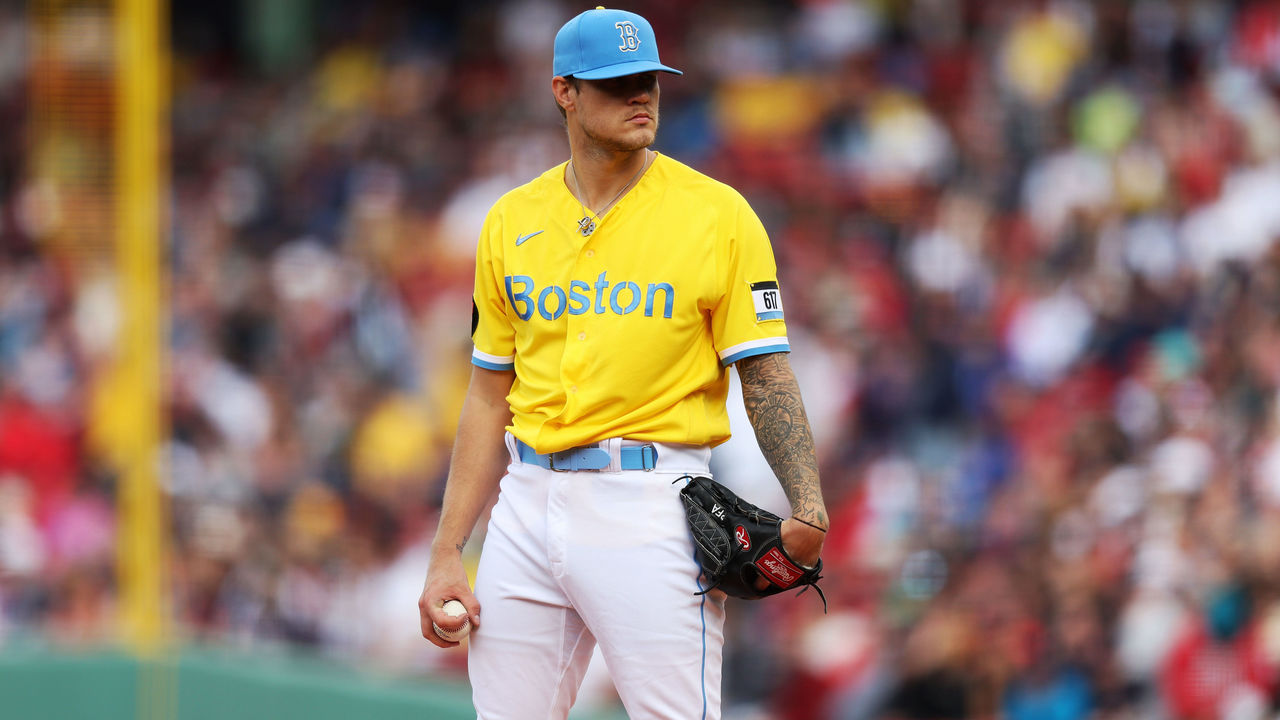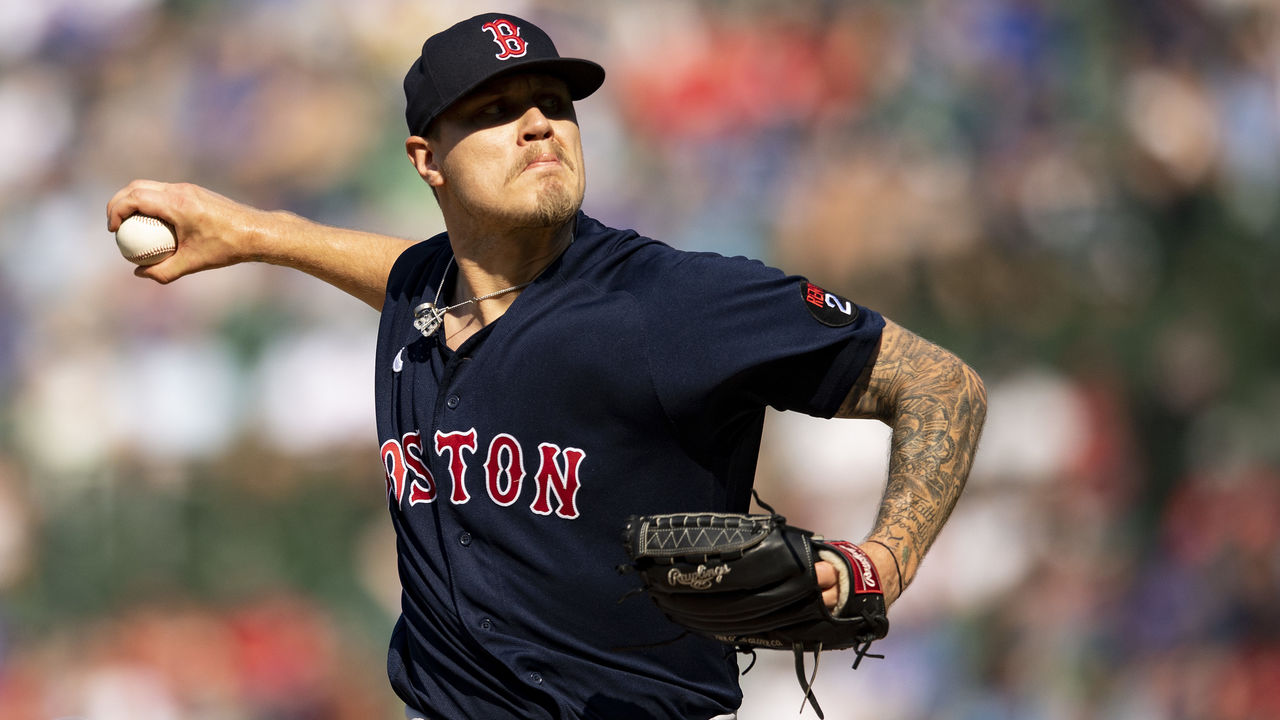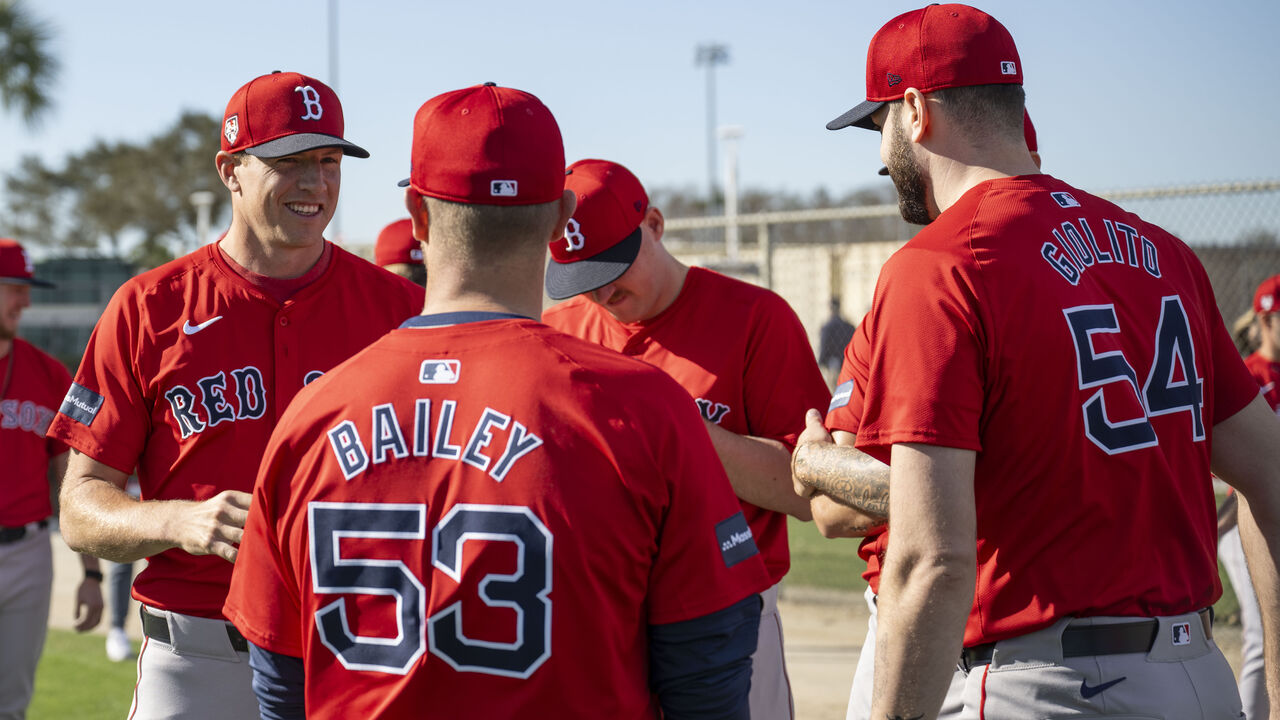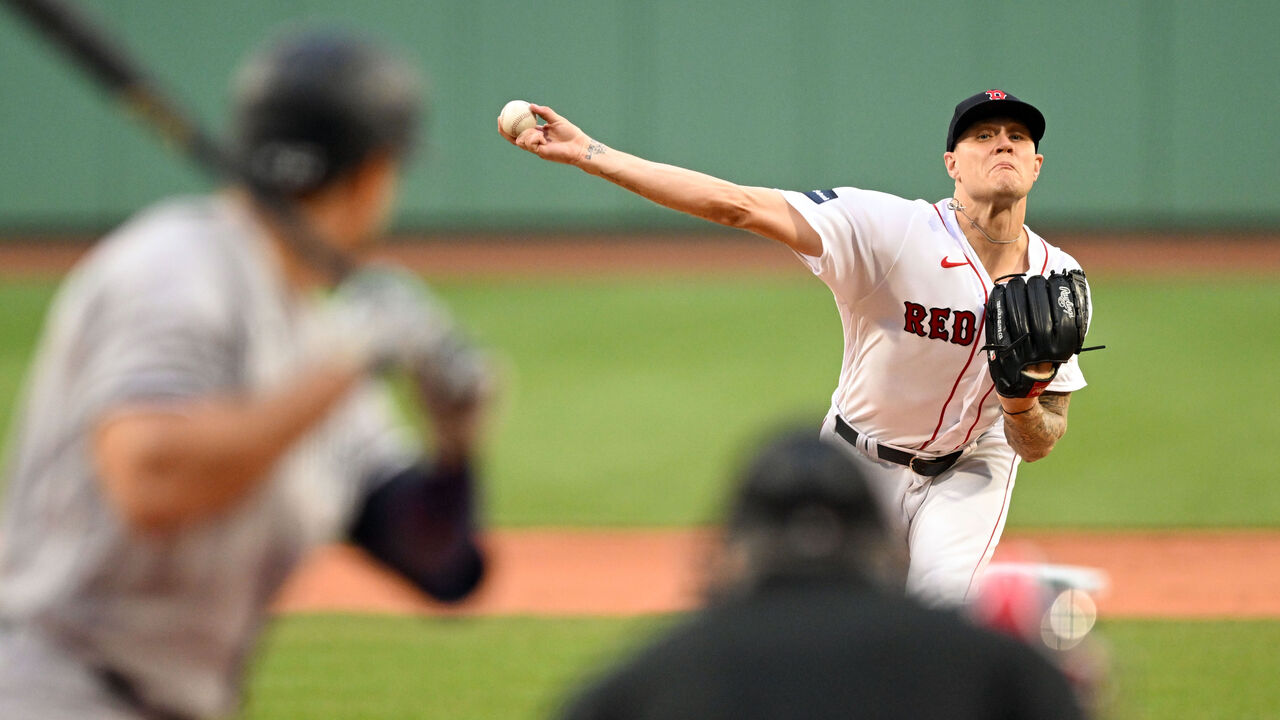Inside the reinvention of Tanner Houck
One of this season's early breakout stories began as so many modern collaborations do: with a Zoom call.
Boston Red Sox pitcher Tanner Houck opened his laptop one afternoon last winter at his offseason home in West Palm Beach, Florida, and met with the club's new pitching coach, Andrew Bailey. Bailey had a plan to present.
Bailey - a former big leaguer - came to Boston with a reputation for performing small miracles in San Francisco, like the player development success of Logan Webb. That alone had Houck's attention. Houck's skill set and problems caught Bailey's eye.
After Bailey joined the Red Sox in November, he faced a winter cram session to learn as much about the new pitchers he'd be working with live in less than three months. Each day, after dropping his kids off at school and daycare, Bailey would go to his small home office and engage in deep dives on all the arms he was inheriting. He wanted to understand their strengths and weaknesses.
Houck was an interesting case.
The stuff was there. He had above-average movement on a number of his offerings. He could reach back and throw 97 mph. He always looked the part with an imposing 6-foot-5, 230-pound frame and a pointed, blond goatee. But at times he seemed to be allergic to throwing pitches over the plate. Results were uneven. He shuffled between the rotation and bullpen in his first three years in the majors, and last season, his fourth, he worked exclusively as a starter but was 6-10 with a 5.01 ERA.
Bailey saw a path to helping Houck improve. During their virtual meeting, Houck looked at the accompanying heat maps, data, and videos Bailey shared on the screen to underscore his points.
Houck's been a revelation since.

He's second in the majors in pitching fWAR early this season (1.4), just behind teammate Kutter Crawford. His 1.60 ERA is fourth in the American League. The Red Sox own the lowest ERA in the majors (2.58).
"Ultimately, it was having that open mindset to get better and believing in myself," Houck said. "Knowing I have to make a few changes, maybe that's a little scary, but that's OK."
Zeroing in
One of the things Bailey learned while studying Houck was that his pitch quality was excellent but he was putting himself in too many tough spots.
Houck heard two words often this spring while throwing on the sun-soaked bullpens and backfields of Boston's Florida spring training complex.
"I just like to say, 'Over white,'" Bailey said. "'Tanner, you just have to throw the thing over white.' His miss patterns tend to be big east-west.
"I think if you look at Tanner, some of the struggles just stem from count leverage. Just recognizing how good his stuff is, and the quality of pitcher he is. Harnessing the strike zone was key."
Last season, 26.7% of Houck's pitches came when the batter had the count in his favor. That ranked in the middle of the pack, 318th out of 603 pitchers who threw at least 250 pitches.

From 2020-23, Houck's percentage of pitches thrown in the strike zone (49%) ranked 112th out of 154 pitchers with at least 250 innings in that span.
Throwing more strikes is simple in theory. It's more difficult in practice, and a coach imploring you to "throw strikes" isn't offering a real cure.
To funnel Houck into the zone more often, Bailey placed dummy batters in each batter's box in bullpen sessions this spring, creating a visual alleyway. Red Sox coaches also simulated a strike zone by placing strings across the plate at knee and chest height.
Bailey also gamified practice by playing three-pitch bullpen games with Houck. If Houck was ahead of the count after three pitches, he earned a win. If he was behind, a loss. They recorded each day's results and tracked the progress.
For the first time in Houck's career, he's behind batters with fewer than 20% of his offerings this season, the 11th-best rate in the majors. Houck's also tied for the fourth-best percentage of pitches in the strike zone (58%).
On April 17, Houck threw the first shutout and complete game of his career, a three-hitter against Cleveland on only 94 pitches. Such efficiency was unthinkable a year earlier.
"I've always wanted to go six, seven innings every time I go out there," Houck said. "Unfortunately, with how I was pitching in years past, with overthrowing and trying to out-stuff guys, it led to a lot of 3-2 counts, 2-2 counts, a lot of walks. It was as simple as: 'We gotta get you in the zone more with your stuff, and just trusting the other complementary pitches off of your sinker and slider.' I'm very open-minded to any changes that will help me get better in any way, not letting my ego get in the way."
Tanner Houck has 3 starts of 9+ strikeouts and no walks in April. pic.twitter.com/8wxUsjZ2op
— Red Sox (@RedSox) April 29, 2024
While command is thought to be one of the more difficult skills to improve, Houck is evidence that dramatic turnarounds are possible.
And trusting his stuff in the strike zone is linked to another key change.
'Different ways to get outs'
Houck's best stretch as a professional comes in a season in which his average fastball velocity is down nearly 2 mph (93.9 mph) from its peak in 2022 (95.5 mph).
Part of the plan outlined with Bailey revolved around the goal of getting ahead, but also that less velocity could result in more success.
That's a different message than just about every other amateur or professional pitcher is hearing these days.

Webb's transformation was brought up as an example in their Zoom call.
As a minor leaguer with the Giants, Webb focused on maximum velocity and throwing up in the zone with a four-seam fastball - a popular strategy in the Statcast era. It wasn't until Webb began to rely more on movement and location under Bailey and Brian Bannister that he became a front-of-the-rotation workhorse.
Houck operates with a three-quarter arm slot like Webb. He has a slider and two-seamer like Webb, too.
"We know the harder you throw, the more success you are likely to have on any pitch type," Bailey said. "We want to train velocity with certain guys, of course. But I don't think every pitcher needs to be throwing 96, 97. I think there are different ways to get outs now: usage and location. It's not all just predicated on velocity."
The above-average movement on Houck's two-seam fastball is working like it did a year ago, dropping 31 inches from its release point on average.
Bailey suggested Houck's slider should move more horizontally to oppose his sinker, and it's now moving 16 inches this year compared to 11 last year. It went from below-average to above-average sweep.
Tanner Houck is dealing on #SundayNightBaseball! pic.twitter.com/u3Z2ElziFu
— MLB (@MLB) April 29, 2024
"I'd always tried to reach back and hit the bigger velos," Houck said. "I felt like I was always giving 120% effort with it. I was overdoing it, causing a lot of timing issues, causing a lot of overthrowing, a lot of missing.
"At the end of the day, I had to look at myself in the mirror and realize if I throw at 91-94, it's more beneficial than overthrowing and missing spots.
"Because ultimately that 2-3 mph difference doesn't really beat hitters in today's game. They're used to seeing big velocity. I kind of just had to look at myself in the mirror and understand that I'm not a guy that's (throwing) 97-100, blowing doors away."
Simplifying
During his offseason study, Bailey looked at Houck's movement "clock" charts, or pitch-shape groupings, which show how each offering in a pitcher's arsenal moves relative to the others. Pitch pairings ideally play off each other, moving in opposite directions like mirror images.
Bailey said Houck's clock chart was kind of "chaotic." He saw a pitcher trying to do too much. He'd seen it before.
"When I first met Logan, I think he threw the four-seam (fastball) 30% of the time, and had a little cutter, and two different breaking balls," Bailey said. "It was kind of a bigger arsenal. Just trying to trim that down to: 'OK, what do you do really well? How do you get down the mound? How does your body naturally unwind to deliver certain pitch types, and movement profiles that are outliers? How does it enter the zone from a vertical and horizontal approach angle?'
"You can grip any pitch type and throw it. Just because you can throw a curveball doesn't mean it's a good curveball. So, taking all of that into account and really paring down Tanner's best weapons."
They eliminated the four-seamer employed as Houck's primary pitch in 2020 and 2021. His cutter was largely shelved, too.
His slider was always his best pitch, and it was to remain a primary weapon. His two-seam fastball paired better with it. It was a pitch Houck nearly gave up on three years earlier. A fellow University of Missouri product, Max Scherzer, suggested he stick with it.
Tanner Houck, 94mph Two Seamer and 85mph Slider, Overlay. pic.twitter.com/oiuTo5cyBP
— 野球しようぜ (@7hodvj9oCM78910) April 9, 2024
"The first year I started throwing it, I hated it. I'll admit it. I was like, 'This is just a terrible sinker. Why am I throwing this?' I had a bad attitude with it," Houck said. "(Scherzer's) advice at the time was: 'Listen, it takes three years. Three years of hard work and throwing numerous ones on flat grounds and in bullpens and with different grip changes.'"
Each year, the pitch's movement profile became incrementally better. Each year, Houck's confidence in it grew. Compared to last year, it's added three inches of vertical break, now falling 12% more than league average. His usage of it nearly doubled from 6% in 2022 to 11% last year, and has nearly doubled again this year (21%).
"This year changed the mindset, just fully trusting that it's a good pitch," Houck said.
And like many other Red Sox pitchers enjoying improved performances this year, Houck is throwing his fastball less and his secondary offerings more.
He doesn't even have a primary pitch; he uses his slider most often (42%), followed by his two-seamer (31%) and splitter (21%).
All three rate as above-average offerings according to FanGraphs' pitch metrics, making for a difficult guessing game for hitters.

Bailey doesn't aim for any pitch-usage thresholds. He has a simple philosophy instead:
"Relentlessly attack the zone with your greatest strengths," Bailey said.
It's easier said than done, and, yes, it's still early in the season. But Houck so far is demonstrating there are different ways to get guys out, that one can zig when everyone else is zagging.
Once an erratic arm, Houck finds himself in total command of his new, best professional self.
Travis Sawchik is theScore's senior baseball writer.